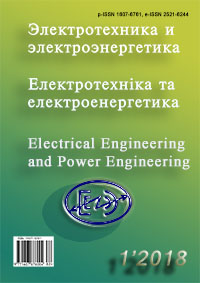INVESTIGATION OF THE FREQUENCY-TEMPERATURE RELATIONSHIP OF THE DIELECTRIC PERMITTIVITY OF THE PZT PIEZOCERAMICS IN THE LOW FREQUENCY RANGE
DOI:
https://doi.org/10.15588/1607-6761-2018-1-2Keywords:
frequency-temperature relationship, dielectric permittivity, PZT piezoceramics, low-frequency rangeAbstract
Purpose. To investigate the frequency-temperature relationship of the dielectric permittivity of PZT piezoceramics in the low frequency range.
Methodology. To obtain the frequency-temperature relationship of the dielectric permittivity of the PZT piezoceramics, a technique was used to determine the capacitance of the capacitor, between which plates the sample was placed. The value of the dielectric permittivity of the sample was calculated from the capacitor capacitance obtained.
Findings. The frequency-temperature relationship of the dielectric permittivity of the PZT piezoceramics in the low frequency range has been obtained by the authors. The dielectric permittivity is not practically related to the frequency of the alternating voltage at a low temperature, with increasing in temperature its value increases and frequency relationship is observed. The temperature relationship of the dielectric permittivity of the PZT piezoceramics is satisfactorily described by the exponential functional dependence in the low-temperature range. The activation energy of the PZT piezoceramics polarization is determined from the graph of the dependence of the logarithm of the dielectric permittivity upon the inverse temperature. Different values of the activation energy for the two temperature regions prove on the existence of different mechanisms of the PZT piezoceramics polarization in the temperature range being investigated.
Originality. The authors investigated the frequency-temperature relationship of the dielectric permittivity of the PZT piezoceramics in the low-frequency range. It is established that the temperature relationship of the dielectric permittivity of the PZT piezoceramics is satisfactorily described by an exponential functional relationship in the lowtemperature range. The activation energy of polarization is determined for two temperature sections.
Practical value. The research results can be used to study the mechanism of polarization of PZT piezoceramic materials operating in electrical and electronic products under the influence of alternating electric fields of different frequencies and temperature changes.
References
[1] Glozman, I.A. (1972). P'ezokeramika, M, Jenergija, 288. [in Russian]
[2] Tareev, B.M. (1982). Fizika dijelektricheskih materialov, M, Jenergoizdat, 320. [in Russian]
[3] Poplavko, Ju.M. (1980). Fizika dijelektrikov, K, Vishha shkola, 400. [in Russian]
[4] Rez, I.S. (1989). Dijelektriki. Osnovnye svojstva i primenenie v jelektronike, M, Radio i svjaz', 288. [inRussian]
[5] Gusev, Ju.A. (2008). Osnovy dijelektricheskoj spektroskopii, Kazan', Kazan. gos. un-t, 112. [in Russian]
[6] Aleksandrov, K. S. (2004). Perovskity, nastojashhee i budushhee, Novosibirsk, Izd-vo Sib. Otdnie RAN, 230. [in Russian]
[7] Bell, A.J. (2008). Ferroelectrics: The role of ceramic Sci. and engineering, J. Eur. Ceraam. Soc, 28, 1307-1317. [in Russian]
[8] Venevcov, Ju.N. (1968). Segnetojelektriki, Rostovna-Donu, Izd-vo Rost. Un-ta, 155. [in Russian]
[9] Lajns, M. (1981). Segnetojelektriki i rodstvennye materialy, M, Mir, 736. [in Russian]
[10] Smolenskij, G.A. (1985). Fizika segnetojelektricheskih javlenij, L, Nauka, 396. [in Russian]
[11] Rabe, K.M. (2011). Fizika segnetojelektrikov: sovremennyj vzgljad, M, BINOM. Laboratorija znanij, 440. [in Russian]
[12] Golovnin, V.A. (2013). Fizicheskie osnovy, metody issledovanija i prakticheskoe primenenie p'ezomaterialov, M, Tehnosfera, 272. [in Russian]
[13] Zolotarevskiy, A., & Lushchin, S. (2017). The study of the spectral relationship of the dielectric permittivity of polar dielectrics in the low frequency range. Electrical Engineering And Power Engineering, 1, 6-11. doi:http://dx.doi.org/10.15588/1607-6761-2017-1-1 [in Russian]
[14] Rassalsky, A., Sakhno, A., Konogray, S., & Kozlov, A. (2010). Measuring and processing technique of complex conduction current of 110–750 kV highvoltage equipment basic insulation at diagnostics under operating voltage. Electrical Engineering And Power Engineering, 2, 12-17. doi:http://dx.doi.org/10.15588/1607-6761-2010-2-3 [in Russian]
[15] Malyushevskaya, A., & Toporov, S. (2016). Composition and morphology of capacitor polymer films’ influence on the thermostability of their short-term electric strength. Electrical Engineering And Power Engineering, 1, 18-24. doi:http://dx.doi.org/10.15588/1607-6761-2016-1-3 [in Ukraine]
[16] Malyushevska, A., Toporov, S., & Gunko, V. (2017). Long-term electrical strength of polymer films under the electrical field influence. Electrical Engineering And Power Engineering, 1, 12-17. doi:http://dx.doi.org/10.15588/1607-6761-2017-1-2 [in Ukraine]
[17] Fesenko, E.G. (1972). Semejstvo perovskita i segnetojelektrichestvo, M, Atomizdat, 248. [in Russian]
[18] Galasso, F.S. (1969), Structure properties and Preparation of Perovskite-type Compounds, GalassoNew York, Pergamon Press, 364. [in Russian]
[19] Galijarova, N.M. (2014). Prostejshaja klassifikacija tipov dijelektricheskogo otklika provodimosti i shumov i ee fraktal'nye obobshhenija. Izvestija RAN. Ser. Fizichesaja, 78, 10, 1220-1227. [in Russian]
Downloads
Published
How to Cite
Issue
Section
License
Copyright (c) 2018 ZOLOTAREVSKIY A.I., LUSHCHIN S.P.

This work is licensed under a Creative Commons Attribution 4.0 International License.
Creative Commons Licensing Notifications in the Copyright Notices
Authors who publish with this journal agree to the following terms:
Authors retain copyright and grant the journal right of first publication with the work simultaneously licensed under aCreative Commons Attribution License that allows others to share the work with an acknowledgement of the work's authorship and initial publication in this journal.
Authors are able to enter into separate, additional contractual arrangements for the non-exclusive distribution of the journal's published version of the work (e.g., post it to an institutional repository or publish it in a book), with an acknowledgement of its initial publication in this journal.
Authors are permitted and encouraged to post their work online (e.g., in institutional repositories or on their website) prior to and during the submission process, as it can lead to productive exchanges, as well as earlier and greater citation of published work.

